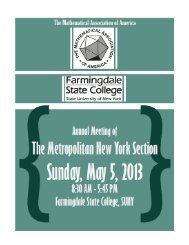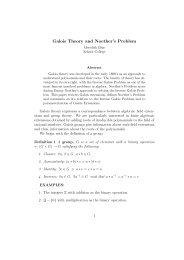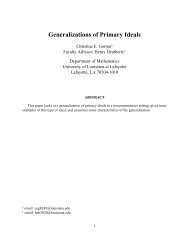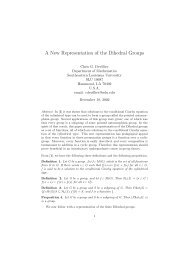Presentation Abstracts - MAA Sections
Presentation Abstracts - MAA Sections
Presentation Abstracts - MAA Sections
Create successful ePaper yourself
Turn your PDF publications into a flip-book with our unique Google optimized e-Paper software.
IYS.3 Nicholas Pritchard Coastal Carolina University<br />
Jacqueline Leake (undergraduate student)<br />
The Advantage of the Coin Toss for the New Overtime System in the National Football League<br />
In 1974, the National Football League (NFL) instituted a sudden death overtime to hopefully reduce the amount of ties<br />
during the regular and post seasons. Since then, overtime in the NFL has been a highly debated topic. Empirical<br />
evidence has shown that the coin toss winner has a significant advantage since the first team to score wins the game. In<br />
fact, from 1994 – 2009, 59.4% of teams who won the coin toss at the beginning of overtime went on to win the game. In<br />
addition to empirical evidence, Michael Jones (2004) modeled sudden death overtime in the NFL using absorbing state<br />
Markov chains and found theoretical results similar to the empirical results. In 2010, the NFL instituted a new overtime<br />
system to be implemented only during the playoffs beginning in 2011. Under this new system, both teams get to attempt<br />
at least one offensive series unless a touchdown is scored by the team with the ball first. This new system was fully<br />
implemented into the regular season in 2012. Since it has only been in effect for one complete regular season, it is<br />
difficult to see from data if the new overtime system reduces the advantage of the coin toss winner. This talk will<br />
examine a model for the probability of winning in overtime under the new NFL system after winning the coin toss using<br />
the law of total probability and absorbing state Markov chains.<br />
GT1.2 Ashley Rand University of Tennessee, Knoxville<br />
Non-Unique Factorizations of Polynomials<br />
The Fundamental Theorem of Arithmetic tells us that any positive integer can be uniquely factored as a product of<br />
positive prime numbers. This gives us a nice structure to teach College Algebra students, but it is much more interesting<br />
when we have non-unique factorization. In this talk, we explore polynomial subrings where we have non-unique<br />
factorizations. Specifically, we determine when all of the factorizations of these polynomials will include at least one<br />
reducible element.<br />
RES3.2 Christopher Raridan Clayton State University<br />
Christian Barrientos<br />
Mean Labelings of Outerplanar Graphs<br />
Mean labelings were introduced in 2003 in the context of additive vertex labelings. In this case, nonnegative integers are<br />
assigned to the vertices of a graph in such a way that all edge weights are different, where the weight of an edge is defined<br />
as the average of the labels on its end vertices rounded up to the next integer. In this presentation, we explore mean<br />
labelings of outerplanar graphs.<br />
GT2.2 Natalie Rose Rich Wake Forest University<br />
Knots and Links in the Complete Directed Graph on Six Vertices<br />
We define the complete directed graph J6 to be the set of six vertices with the property that every pair of distinct vertices<br />
is connected by exactly one pair of edges such that each of the two edges e and e' connecting the same two vertices has a<br />
direction assigned to it such that the initial point of e is the terminal point of e' and the initial point of e' is the terminal<br />
point of e. We define a triangle in J6 to be a set of three vertices and three edges connecting them such that for every two<br />
of the three consecutive edges that form the triangle, the initial point of one edge is the terminal point of the other edge.<br />
We say that two disjoint triangles form a nontrivial link if they are impossible to pull apart or if one (or both) of the<br />
triangles contains a nontrivial knot. This presentation features results that were obtained through efforts to prove that J6 is<br />
intrinsically linked (that is, J6 contains a nontrivial link no matter how we position it in space).<br />
GME2.4 Josie Ryan Lander University<br />
A Look at University Preparedness of Incoming Freshmen<br />
An interactive look at preparedness of incoming university students as compared to university expectations. Where are our<br />
students excelling? Where do they need improvement? A look at the book I am writing based on talks I have given to<br />
parents of home school and regular high school students about university expectations in mathematics and beyond. How<br />
do you answer the question “Should my child take Calculus in high school?” What needs are we seeing? Is there a real<br />
increase in helplessness, a decrease in knowledge, or simply generational perception? If you had the opportunity, what<br />
would you tell parents of elementary, middle, and high school students?

















